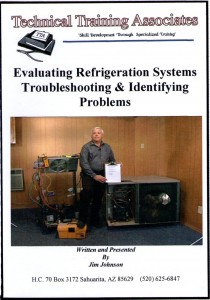As stated in the Dec. 1 article, if there is a low temperature difference across the evaporator coil in an air conditioning system, the problem is a refrigerant flow problem, not an airflow problem. The low temperature difference also indicates a capacity drop, meaning that the heat-handling capabilities of the system have failed. If we assume that the A/C system was started and has run for some time under these conditions, the service problem could not be electrical.
Cooling Coil Size
The larger the coil surface area of the evaporator, the closer the coil temperature will be to the entering air temperature. This happens because of a higher operating coil temperature with a larger coil. The A/C unit would be running higher evaporating (suction) pressures and temperatures. With this increase in vapor pressure and coil temperature, the A/C unit would experience higher efficiencies from the higher-pressure (more dense) refrigerant gases entering the reciprocating compressor each revolution of its crankshaft.The compressor ratio would also decrease from the higher evaporator temperatures and pressures, causing the mass flow rate of refrigerant vapors through the compressor to increase. These are the reasons why manufacturers have been manufacturing A/C coils that are larger and more efficient. A larger and more efficient coil does increase the manufacturing cost, but increased unit efficiency hopefully will offset these higher costs.
The term used to describe the A/C unit's efficiency is the Energy Efficiency Rating (EER).
However, one has to remember that coil surface area may vary from one manufacturer to another. One manufacturer may choose large coil areas for high suction pressures and smaller compressors. Another may go with smaller surface area coils causing lower suction pressures and use larger compressors. As long as the A/C unit meets the required Btu and EER ratings, it is a tradeoff.
Often coil surface area is a function of geographic regions. Large surface coils running higher suction pressures may not have low enough coil temperatures, and thus may not be able to remove enough moisture (latent heat). Their apparatus dew point will be too high to condense the right amount of moisture from the air passing through the coil. This may cause high humidity, mold, and human discomfort problems.
Condensers
Other than having different pressures and temperatures, the condenser and evaporator are very similar. Condensers are usually a bit larger than the evaporator in order to handle not only the evaporator load, but also the suction line superheat gain, heat of compression, and motor heat loads of the compressor.Like the evaporator, the surface area of the condenser also affects the design temperature difference between the condensing temperature and the ambient (surrounding temperature). The larger the condenser, the lower the condensing temperature will be. The larger the condenser, the more expensive it is to manufacture. But the EER will be much higher.
So, what should the condensing temperature and pressure be? Believe it or not, condensing temperatures and pressures will vary with coil surface area size and EER just as evaporator temperatures and pressures did. As coil surface area increases, condensing pressures and temperatures will decrease.
Refrigerant Subcooling In The Condenser
Subcooling is defined as the difference between the measured liquid temperature and the saturation temperature at a given pressure. Condenser subcooling can be measured at the condenser outlet with a thermometer or thermocouple and a pressure gauge.Simply subtract the condenser outlet temperature from the saturation temperature at the condenser outlet to get the amount of liquid subcooling in the condenser. The saturation pressure has to be measured at the condenser outlet and converted to a temperature. Always take the pressure at the same point the temperature is taken. This will alleviate any pressure drop error through the condenser.
A forced-air condenser will usually have from 6 to 10 degrees of liquid subcooling if charged properly. However, the amount of condenser subcooling depends on the static and friction line pressure losses in the liquid line, and will vary from system to system. The 6 to 10 degrees of liquid subcooling is assuming no liquid amplification pump is pressurizing the liquid out of the condenser. Condenser subcooling can be an indicator of the refrigerant charge in the system.
For systems without receivers, the less the refrigerant charge, the less the subcooling. The rated EER will have little or no effect on condenser subcooling.
Another factor that will affect condenser subcooling is the condenser air entering temperature (CAET). As the CAET increases, the liquid subcooling will decrease. This is because higher condensing (head) pressures will force more of the subcooled liquid through the metering device to the evaporator. This will also affect evaporator superheat. Assuming the A/C system does not have a thermostatic expansion valve (TXV) for a metering device, the evaporator superheat will be less from the increased flow rate through its coil.
Liquid Line Restriction
Liquid line restrictions can result from many causes, including a restricted filter-drier, a restricted TXV screen, a kinked liquid line, a kinked or bent U bend on the lower condenser coil, a restricted solder joint in the liquid line, or an oil-logged capillary tube.A restricted liquid line will starve the evaporator of refrigerant, thus causing low pressures in the evaporator. If the evaporator is starved of refrigerant, the compressor and condenser will also be starved. The evaporator will not be absorbing very much heat for the condenser to reject. However, most of the refrigerant will be in the condenser and not necessarily causing high head pressures because of the reduced heat load on the evaporator.
Because most of the refrigerant charge is in the condenser, liquid subcooling in the condenser will increase. This is a big difference from an undercharge of refrigerant. An undercharge of refrigerant will have low condensing subcooling. If the system has a receiver, most of the refrigerant will be in the receiver, causing lower than normal head pressures.
Here are some more symptoms of a liquid line restriction:
Restricted Suction Line
The suction line is much more sensitive than the liquid line. This is because much less dense refrigerant (vapor instead of liquid) flows through the suction line than the liquid line. A restricted suction line will cause low suction pressures and also a starved compressor and condenser. A starved compressor will lead to low compressor amp draws because of its lightened load.The condensing pressure will also be low because of its light load. Since suction line restrictions starve the compressor of refrigerant, the entire mass flow rate of refrigerant will decrease through the system, causing high superheats from inactive evaporators.
Restricted and/or dirty suction filters are the major cause of suction line restrictions. If there is a suction line restriction, liquid subcooling in the condenser will be normal to a bit high since a lot of refrigerant will be in the condenser coil, but the refrigerant is not being circulated very fast. The condenser subcooling may be normal to a bit high if there is a receiver in the system. This subcooling in the condensing lets the technician know that there is refrigerant in the system and that an undercharge of refrigerant can be ruled out.
Undercharge
Undercharged systems mean less mass flow rate throughout the entire system again. Low suction and discharge pressures with high superheat in the evaporator are all indications of an undercharge. Severely undercharged systems will run very low condenser subcooling because there is no refrigerant to subcool.If the subcooling drops to zero, the hot gas in the condenser will start to leave the condenser with some liquid; thus bubbles will form in the sight glass if the system is fortunate enough to have one.
Compressor amp draw will be low because of the decreased refrigerant flow. Technicians will usually confuse themselves over an undercharge of refrigerant and a liquid line restriction. Remember, a liquid line restriction will give the system a lot of subcooling in the condenser, whereas an undercharge will not. Otherwise, symptoms are very similar.
Overcharge
A system with an overcharge of refrigerant will have higher than normal condensing temperatures because liquid backs up in the condenser, robbing the condenser of useful condensing area. The elevated head pressure causes the volumetric efficiency of the compressor to decrease because of higher pressures of the re-expanding clearance volume vapors in the clearance pocket of the compressor. The amp draw of the compressor will increase from the higher head pressure. Higher head pressures also create higher compression ratios, and the entire system will have reduced capacities.If the system has a TXV metering device, the TXV will still try to maintain its superheat and the evaporator pressure will be normal to slightly high, depending on the amount of overcharge.
The higher evaporator pressure will be caused from the decreased mass flow rate from the higher compression ratio, and the evaporator will have a hard time keeping up with the higher heat load of the warm entering air temperature. The TXV will have a tendency to overfeed on its opening strokes due to the high head pressures.
If we are dealing with a capillary tube metering device, the same symptoms occur with exceptions to evaporator superheat. Remember, one reason a capillary tube system is critically charged is to prevent flooding of the compressor on low evaporator loads. The higher head pressures of an overcharged capillary tube system will have a tendency to overfeed the evaporator, thus decreasing the superheat.
If the system is more than 10 percent overcharged, liquid can enter the suction line and get to the suction valves or crankcase. This will result in compressor damage and soon failure.
Next month, we will look at compressor inefficiencies as factors in refrigerant flow problems.
John Tomczyk is a professor of HVACR at Ferris State University, Big Rapids, Mich. He can be reached by e-mail at tomczykj@tucker-usa.com.
Publication date: 01/12/2004







